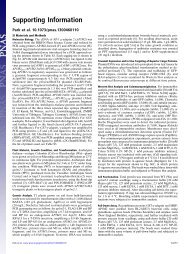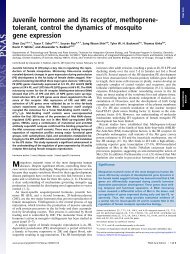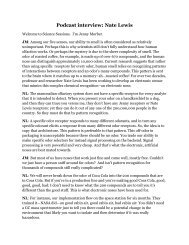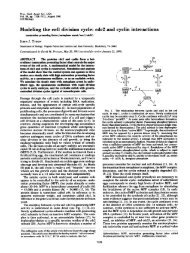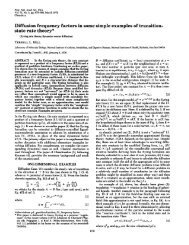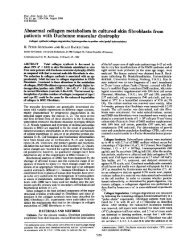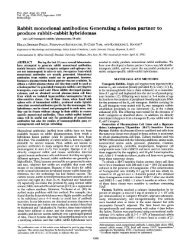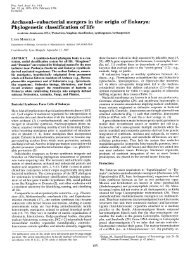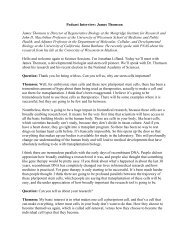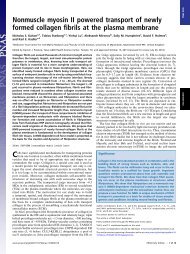Cysteine protease inhibitors as chemotherapy - Proceedings of the ...
Cysteine protease inhibitors as chemotherapy - Proceedings of the ...
Cysteine protease inhibitors as chemotherapy - Proceedings of the ...
Create successful ePaper yourself
Turn your PDF publications into a flip-book with our unique Google optimized e-Paper software.
Colloquium Paper: Selzer et al. Proc. Natl. Acad. Sci. USA 96 (1999) 11017<br />
Table 2. Inhibition <strong>of</strong> cysteine <strong>prote<strong>as</strong>e</strong>s with K11002<br />
Enzyme kinact, s �1 Ki, �M kinact�Ki, s �1 �M �1<br />
L. major cpB 0.021 � 0.0014 0.205 � 0.077 107,000 � 32,000<br />
Cruzain 0.064 � 0.027 0.17 � 0.074 383,000 � 27,000<br />
Papain 0.072 � 0.009 0.261 � 0.025 275,000 � 10,000<br />
Mammalian ca<strong>the</strong>psin B 0.014 � 0.001 9.8 � 2.3 1,400 � 250<br />
Note <strong>the</strong> similar kinact values versus <strong>the</strong> differences in <strong>the</strong> Ki values that are mainly responsible for <strong>the</strong><br />
divergence <strong>of</strong> <strong>the</strong> second-order rate constants. See Prote<strong>as</strong>e Assays for details <strong>of</strong> <strong>as</strong>say used.<br />
Animal Research. Two � 10 5 metacyclic L. major (WHOM�<br />
IR�173) were obtained by peanut agglutinin selection <strong>as</strong><br />
previously described (18) and were injected into each hind<br />
footpad <strong>of</strong> female BALB�c mice (18–20 g, Simonsen Laboratories,<br />
Gilroy, CA). Strain WHOM�IR�173 w<strong>as</strong> used because<br />
<strong>of</strong> its higher virulence in mice compared with strain<br />
LV39(MRHO�SU�59�P). Compounds were dissolved in<br />
100% DMSO and stored at �20°C. The final concentrations<br />
were adjusted with sterile water to give a 70:30 (vol�vol)<br />
DMSO�H2O mixture. Twenty-four hours after infection, mice<br />
were treated with 100 �l <strong>of</strong> K11002 or ZLIII115A (100 mg�kg<br />
per day, every day, 4 weeks, intraperitoneal) in ei<strong>the</strong>r a single<br />
dose or split into two treatments per day. Each set tested<br />
consisted <strong>of</strong> five mice, including an untreated control, a<br />
DMSO-treated control, <strong>as</strong> well <strong>as</strong> uninfected mice treated with<br />
<strong>the</strong> appropriate compound. To monitor <strong>the</strong> course <strong>of</strong> <strong>the</strong><br />
infection, <strong>the</strong> thickness <strong>of</strong> <strong>the</strong> footpads w<strong>as</strong> me<strong>as</strong>ured once a<br />
week by a standard method using a metric caliper (dial<br />
thickness gauge no. 7305; Mitutoyo, Kaw<strong>as</strong>aki, Japan) (19). To<br />
quantify par<strong>as</strong>ite burden, whole footpad histology <strong>as</strong> well <strong>as</strong><br />
limited par<strong>as</strong>ite dilution <strong>as</strong>says from footpad tissues (20) were<br />
performed at <strong>the</strong> end <strong>of</strong> <strong>the</strong> experiments. To investigate side<br />
effects <strong>of</strong> <strong>the</strong> compounds, mouse liver tissue w<strong>as</strong> embedded in<br />
paraffin and 5-�m sections were stained with hematoxylin.<br />
Sections <strong>of</strong> treated tissues were <strong>the</strong>n compared with control<br />
liver tissue.<br />
Cytokine Assays. IL-4 and IFN-� were <strong>as</strong>sayed in inhibitortreated<br />
and untreated mice by monoclonal-b<strong>as</strong>ed ELISA and<br />
normalized to standard controls <strong>as</strong> previously described (20).<br />
RESULTS<br />
The reversible hydrazide <strong>inhibitors</strong>, ZLIII115A and ZLIII43A,<br />
were tested against <strong>the</strong> L. major cpB, cruzain (<strong>the</strong> major cpL<br />
<strong>of</strong> Trypanosoma cruzi), papain, and mammalian ca<strong>the</strong>psin B.<br />
There w<strong>as</strong> 2- to 10-fold higher inhibitory activity toward <strong>the</strong> L.<br />
major cpB versus <strong>the</strong> plant or mammalian <strong>prote<strong>as</strong>e</strong>s (Table 1).<br />
In <strong>the</strong> c<strong>as</strong>e <strong>of</strong> <strong>the</strong> irreversible pseudopeptide inhibitor K11002<br />
(7), <strong>the</strong> first-order inactivation constant (kinact) w<strong>as</strong> similar for<br />
<strong>the</strong> four enzymes. However, differences <strong>of</strong> up to 100-fold were<br />
observed for <strong>the</strong> second-order rate constants (kinact�Ki) (Table<br />
2). The differences in activity <strong>of</strong> <strong>the</strong> mammalian ca<strong>the</strong>psin B<br />
versus <strong>the</strong> plant or par<strong>as</strong>ite <strong>prote<strong>as</strong>e</strong>s are mainly due to<br />
differences in Ki. The L. major cpB, cruzain, and papain were<br />
inhibited to a similar extent. This similarity is consistent with<br />
<strong>the</strong> paradoxical ca<strong>the</strong>psin L-like substrate preference <strong>of</strong> <strong>the</strong> L.<br />
major cpB, due to a single amino acid modification in <strong>the</strong> S2<br />
binding pocket (2).<br />
The three <strong>inhibitors</strong> were next tested in cell cultures <strong>of</strong> L.<br />
major prom<strong>as</strong>tigotes, <strong>the</strong> extracellular stage <strong>of</strong> <strong>the</strong> par<strong>as</strong>ite.<br />
Inhibitors were added to replicating Leishmania <strong>as</strong> a single<br />
dose, and cell growth w<strong>as</strong> monitored for 3 days. Both <strong>the</strong><br />
irreversible and <strong>the</strong> reversible <strong>inhibitors</strong> blocked replication <strong>of</strong><br />
<strong>the</strong> par<strong>as</strong>ite. Concentrations <strong>of</strong> 5 �M inhibited par<strong>as</strong>ite growth<br />
10-fold, where<strong>as</strong> 20 �M and 50 �M completely inhibited cell<br />
growth (Fig. 1). Exchanging <strong>the</strong> medium every day for a total<br />
<strong>of</strong> 3 days, <strong>the</strong>reby keeping inhibitor concentrations stable (20<br />
�M and 50 �M), led to death <strong>of</strong> <strong>the</strong> par<strong>as</strong>ites. After <strong>the</strong> fourth<br />
day <strong>of</strong> this latter experiment, <strong>the</strong> medium w<strong>as</strong> replaced with<br />
fresh medium without inhibitor, and <strong>the</strong> fl<strong>as</strong>ks were again kept<br />
under culture conditions. Even after 10 days no par<strong>as</strong>ites could<br />
be detected, indicating a complete cure <strong>of</strong> <strong>the</strong> Leishmania<br />
culture by <strong>the</strong> cysteine <strong>prote<strong>as</strong>e</strong> <strong>inhibitors</strong>.<br />
To confirm that <strong>the</strong> <strong>inhibitors</strong> could access <strong>the</strong> intracellular<br />
cysteine <strong>prote<strong>as</strong>e</strong>s <strong>of</strong> L. major, prom<strong>as</strong>tigote par<strong>as</strong>ites were<br />
harvested after treatment with 50 �M K11002 for 24 h and<br />
extracted. The residual cysteine <strong>prote<strong>as</strong>e</strong> activity <strong>as</strong> me<strong>as</strong>ured<br />
with <strong>the</strong> fluorogenic substrate Z-Phe-Arg-AMC (which detects<br />
both L. major cpL and cpB activity) in K11002-treated<br />
cells w<strong>as</strong> 20% � 7% (n � 5) relative to <strong>the</strong> control par<strong>as</strong>ites.<br />
Targeting <strong>of</strong> ca<strong>the</strong>psins by K11002 w<strong>as</strong> also confirmed by<br />
‘‘tagging’’ <strong>the</strong> target <strong>prote<strong>as</strong>e</strong>s with radioactively labeled inhibitor<br />
and identification <strong>of</strong> protein species by parallel Western<br />
blot (Fig. 2). The predominant cysteine <strong>prote<strong>as</strong>e</strong> in L. major<br />
prom<strong>as</strong>tigotes is cpB (21), and this species w<strong>as</strong> <strong>the</strong> predominant,<br />
but not exclusive, target <strong>of</strong> <strong>the</strong> vinyl sulfone inhibitor.<br />
The mature catalytic domains <strong>of</strong> L. major ca<strong>the</strong>psins B and L<br />
FIG. 1. Effects <strong>of</strong> K11002 (A) and ZLIII115A (B) on <strong>the</strong> growth <strong>of</strong> L. major prom<strong>as</strong>tigotes. The compounds were added at time point 0, and<br />
cell growth w<strong>as</strong> monitored for 3 days. ZLIII43A showed very similar inhibition pr<strong>of</strong>iles (2). F, Control; ‚, 5�M; E, 20�M; and �, 50�M. Points<br />
are means <strong>of</strong> three independent experiments.



